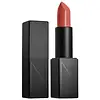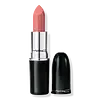What's inside
What's inside
 Key Ingredients
Key Ingredients

 Benefits
Benefits

 Concerns
Concerns

 Ingredients Side-by-side
Ingredients Side-by-side

Ricinus Communis Seed Oil
MaskingBis-Diglyceryl Polyacyladipate-2
EmollientEthylhexyl Palmitate
EmollientCandelilla Cera
EmollientEuphorbia Cerifera Wax
Isononyl Isononanoate
EmollientOzokerite
Emulsion StabilisingButyrospermum Parkii Butter
Skin ConditioningCetearyl Alcohol
EmollientHydrogenated Polycyclopentadiene
Cera Microcristallina
Emulsion StabilisingIsopropyl Myristate
EmollientSilica
AbrasiveCetearyl Ethylhexanoate
EmollientCeteareth-20
CleansingPropylene Carbonate
SolventPolyhydroxystearic Acid
EmulsifyingIsopropyl Titanium Triisostearate
EmollientStearalkonium Hectorite
Gel FormingPolyethylene
AbrasiveCaprylyl Glycol
EmollientCopernicia Cerifera Wax
Phenoxyethanol
PreservativeCoprinus Comatus Extract
AntioxidantLecithin
EmollientCalophyllum Inophyllum Seed Oil
AntimicrobialSimethicone
EmollientTocopheryl Acetate
AntioxidantSorbitan Isostearate
EmulsifyingDextrin
AbsorbentWater
Skin ConditioningHexylene Glycol
EmulsifyingHydrogenated Phosphatidylcholine
EmulsifyingLysolecithin
EmulsifyingPortulaca Pilosa Extract
Skin ConditioningTocopherol
AntioxidantSucrose Cocoate
EmulsifyingAscorbyl Palmitate
AntioxidantPalmitoyl Tripeptide-38
Skin ConditioningDisodium EDTA
Mica
Cosmetic ColorantCI 77891
Cosmetic ColorantCI 77491
Cosmetic ColorantCI 77492
Cosmetic ColorantCI 77499
Cosmetic ColorantCI 45410
Cosmetic ColorantCI 15850
Cosmetic ColorantCI 19140
Cosmetic ColorantRicinus Communis Seed Oil, Bis-Diglyceryl Polyacyladipate-2, Ethylhexyl Palmitate, Candelilla Cera, Euphorbia Cerifera Wax, Isononyl Isononanoate, Ozokerite, Butyrospermum Parkii Butter, Cetearyl Alcohol, Hydrogenated Polycyclopentadiene, Cera Microcristallina, Isopropyl Myristate, Silica, Cetearyl Ethylhexanoate, Ceteareth-20, Propylene Carbonate, Polyhydroxystearic Acid, Isopropyl Titanium Triisostearate, Stearalkonium Hectorite, Polyethylene, Caprylyl Glycol, Copernicia Cerifera Wax, Phenoxyethanol, Coprinus Comatus Extract, Lecithin, Calophyllum Inophyllum Seed Oil, Simethicone, Tocopheryl Acetate, Sorbitan Isostearate, Dextrin, Water, Hexylene Glycol, Hydrogenated Phosphatidylcholine, Lysolecithin, Portulaca Pilosa Extract, Tocopherol, Sucrose Cocoate, Ascorbyl Palmitate, Palmitoyl Tripeptide-38, Disodium EDTA, Mica, CI 77891, CI 77491, CI 77492, CI 77499, CI 45410, CI 15850, CI 19140
Diisostearyl Malate
EmollientCaprylic/Capric Triglyceride
MaskingRicinus Communis Seed Oil
MaskingHydrogenated Polydecene
EmollientBis-Diglyceryl Polyacyladipate-2
EmollientPolyethylene
AbrasiveTrioctyldodecyl Citrate
EmollientPolybutene
Silica
AbrasiveOzokerite
Emulsion StabilisingEuphorbia Cerifera Wax
Octyldodecanol
EmollientCalcium Aluminum Borosilicate
Tocopheryl Acetate
AntioxidantSodium Hyaluronate
HumectantSqualane
EmollientButyrospermum Parkii Butter
Skin ConditioningCocos Nucifera Oil
MaskingGlycine Soja Seed Extract
Skin ConditioningHordeum Vulgare Extract
EmollientOlea Europaea Fruit Oil
MaskingRubus Idaeus Seed Oil
EmollientSimmondsia Chinensis Seed Oil
EmollientTriticum Vulgare Germ Extract
Skin ConditioningC12-15 Alkyl Benzoate
AntimicrobialCeramide Ng
Skin ConditioningTribehenin
EmollientPalmitoyl Hexapeptide-12
Skin ConditioningTitanium/Titanium Dioxide
Cosmetic ColorantAlumina
AbrasiveSynthetic Fluorphlogopite
Aluminum Calcium Sodium Silicate
Calcium Sodium Borosilicate
Tin Oxide
AbrasivePEG-10 Phytosterol
EmulsifyingLinoleic Acid
CleansingEthylhexyl Hydroxystearate
EmollientPhytosteryl Isostearate
Skin ConditioningHydrogenated Castor Oil
EmollientVanillin
MaskingTetrahexyldecyl Ascorbate
AntioxidantPhenoxyethanol
PreservativeMica
Cosmetic ColorantCI 77891
Cosmetic ColorantCI 77491
Cosmetic ColorantCI 77492
Cosmetic ColorantCI 77499
Cosmetic ColorantCI 77163
Cosmetic ColorantCI 77400
Cosmetic ColorantCI 42090
Cosmetic ColorantCI 75470
Cosmetic ColorantCI 15850
Cosmetic ColorantCI 45380
Cosmetic ColorantCI 45410
Cosmetic ColorantCI 73360
Cosmetic ColorantCI 17200
Cosmetic ColorantCI 19140
Cosmetic ColorantCI 15985
Cosmetic ColorantDiisostearyl Malate, Caprylic/Capric Triglyceride, Ricinus Communis Seed Oil, Hydrogenated Polydecene, Bis-Diglyceryl Polyacyladipate-2, Polyethylene, Trioctyldodecyl Citrate, Polybutene, Silica, Ozokerite, Euphorbia Cerifera Wax, Octyldodecanol, Calcium Aluminum Borosilicate, Tocopheryl Acetate, Sodium Hyaluronate, Squalane, Butyrospermum Parkii Butter, Cocos Nucifera Oil, Glycine Soja Seed Extract, Hordeum Vulgare Extract, Olea Europaea Fruit Oil, Rubus Idaeus Seed Oil, Simmondsia Chinensis Seed Oil, Triticum Vulgare Germ Extract, C12-15 Alkyl Benzoate, Ceramide Ng, Tribehenin, Palmitoyl Hexapeptide-12, Titanium/Titanium Dioxide, Alumina, Synthetic Fluorphlogopite, Aluminum Calcium Sodium Silicate, Calcium Sodium Borosilicate, Tin Oxide, PEG-10 Phytosterol, Linoleic Acid, Ethylhexyl Hydroxystearate, Phytosteryl Isostearate, Hydrogenated Castor Oil, Vanillin, Tetrahexyldecyl Ascorbate, Phenoxyethanol, Mica, CI 77891, CI 77491, CI 77492, CI 77499, CI 77163, CI 77400, CI 42090, CI 75470, CI 15850, CI 45380, CI 45410, CI 73360, CI 17200, CI 19140, CI 15985
 Reviews
Reviews

Ingredients Explained
These ingredients are found in both products.
Ingredients higher up in an ingredient list are typically present in a larger amount.
This ingredient is lipid-based synthetic skin-conditioning agent derived from adipic acid and a mixture of fatty acids. It is often called a lanolin substitute.
As an emollient, it helps soften and hydrate the skin. Emollients create a barrier on the skin to trap moisture in.
Due to its fatty acid base, it may not be Malassezia folliculitis safe.
Learn more about Bis-Diglyceryl Polyacyladipate-2This ingredient is also known as shea butter. It is an effective skin hydrator and emollient.
Emollients help soothe and soften your skin. It does this by creating a protective film on your skin. This barrier helps trap moisture and keeps your skin hydrated. Emollients may be effective at treating dry or itchy skin.
Shea butter is rich in antioxidants. Antioxidants help fight free-radicals, or molecules that may harm the body. It is also full of fatty acids including stearic acid and linoleic acid. These acids help replenish the skin and keep skin moisturized.
While Shea Butter has an SPF rating of about 3-4, it is not a sunscreen replacement.
Shea butter may not be fungal acne safe. We recommend speaking with a professional if you have any concerns.
Learn more about Butyrospermum Parkii ButterCi 15850 is the pigment color red. It is an azo dye and created synthetically.
Azo dyes need to be thoroughly purified before use. This allows them to be more stable and longer-lasting.
This ingredient is common in foundations, lipsticks, and blushes. This color is described as brown/orangey red.
It has many secondary names such as Red 6 and Red 7. According to a manufacturer, Red 6 usually contains aluminum.
Learn more about CI 15850CI 19140 is also known as Tartrazine. Tartrazine is a synthetic dye used in cosmetics, foods, and medicine to add a yellow color.
Tartrazine is created from petroleum and is water-soluble.
Some people may experience allergies from this dye, especially asthmatics and those with an aspirin intolerance.
Learn more about CI 19140CI 45410 is a synthetic red-pigment and dye.
It often goes by both Red 28 or Red 27; manufacturers label both ingredients as CI 45410.
This dye is commonly found in makeup because it imparts a vivid color. Some types of this dye change color based on pH level and interaction with moisture:
Your skin has a natural pH of around 4.5 - 5.5.
According to the FDA, CI 45410 is not permitted for use in eye products.
Red 27 is a flourescein dye and commonly used as a fluorescent tracer in medicine.
Learn more about CI 45410Ci 77491 is also hydrated iron III oxide. It's sole purpose is to give a red/pink hue to products.
Iron III oxides are classified as inorganic chemicals for coloring.
Synthetically created Ci 77491 is considered safer than those naturally found. This is because the synthetically created version may contain less impurities. Iron oxides are generally non-toxic and non-allergenic.
Learn more about CI 77491Ci 77492 is also hydrated iron III oxide. It's sole purpose is to give a yellow hue to products.
Iron III oxides are classified as inorganic chemicals for coloring.
Synthetically created Ci 77492 is considered safer than those naturally found. This is because the synthetically created version may contain less impurities. Iron oxides are generally non-toxic and non-allergenic.
Learn more about CI 77492Ci 77499 is also hydrated iron III oxide. It is created from mixing red and black iron oxides. This helps give shades of darkness to a product.
Iron III oxides are classified as inorganic chemicals for coloring.
Ci 77891 is a white pigment from Titanium dioxide. It is naturally found in minerals such as rutile and ilmenite.
It's main function is to add a white color to cosmetics. It can also be mixed with other colors to create different shades.
Ci 77891 is commonly found in sunscreens due to its ability to block UV rays.
Learn more about CI 77891Mica is a naturally occurring mineral used to add shimmer and color in cosmetics. It can also help improve the texture of a product or give it an opaque, white/silver color.
Serecite is the name for very fine but ragged grains of mica.
This ingredient is often coated with metal oxides like titanium dioxide. Trace amounts of heavy metals may be found in mica, but these metals are not harmful in our personal products.
Mica has been used since prehistoric times throughout the world. Ancient Egyptian, Indian, Greek, Roman, Aztec, and Chinese civilizations have used mica.
Learn more about MicaOzokerite is a naturally occuring mineral wax. In cosmetics, ozokerite is used as a texture enhancer.
Ceresin wax is derived from this ingredient.
The melting point of ozokerite is 58-100 C.
Ozokerite is found all over the world including Scotland, the US, and India.
Learn more about OzokeritePhenoxyethanol is a preservative that has germicide, antimicrobial, and aromatic properties. Studies show that phenoxyethanol can prevent microbial growth. By itself, it has a scent that is similar to that of a rose.
It's often used in formulations along with Caprylyl Glycol to preserve the shelf life of products.
Polyethylene is a synthetic ingredient that helps the skin retain moisture. It is a polymer.
It is also typically used within product formulations to help bind solid ingredients together and thicken oil-based ingredients. When added to balms and emulsions, it helps increase the melting point temperature.
Ricinus Communis Seed Oil is the INCI name for castor oil.
Castor Oil helps moisturize the skin. It is rich in a fatty acid called ricinoleic acid. This fatty acid helps prevent moisture loss on the skin. This helps keep your skin soft and hydrated. Ricinoleic acid also has anti-inflammatory and pain reducing properties.
Besides hydrating the skin, castor oil is also used to hydrate hair. By keeping the hair shaft moisturized, breakage is decreased. More studies are needed to show castor oil's effective on stimulating hair growth.
Castor oil is created by cold-pressing castor seeds and then purifying the oil with heat. It was used in Ancient Egypt as fuel in lamps and to help treat eye irritation.
The term 'fragrance' is not regulated in many countries. In many cases, it is up to the brand to define this term. For instance, many brands choose to label themselves as "fragrance-free" because they are not using synthetic fragrances. However, their products may still contain ingredients such as essential oils that are considered a fragrance.
Learn more about Ricinus Communis Seed OilSilica, also known as silicon dioxide, is a naturally occurring mineral. It is used as a fine, spherical, and porous powder in cosmetics.
Though it has exfoliant properties, the function of silica varies depending on the product.
The unique structure of silica enhances the spreadability and adds smoothness, making it a great texture enhancer.
It is also used as an active carrier, emulsifier, and mattifier due to its ability to absorb excess oil.
In some products, tiny microneedles called spicules are made from silica or hydrolyzed sponge. When you rub them in, they lightly polish away dead skin layers and enhance the penetration of active ingredients.
Learn more about SilicaTocopheryl Acetate is AKA Vitamin E. It is an antioxidant and protects your skin from free radicals. Free radicals damage the skin by breaking down collagen.
One study found using Tocopheryl Acetate with Vitamin C decreased the number of sunburned cells.
Tocopheryl Acetate is commonly found in both skincare and dietary supplements.
Learn more about Tocopheryl AcetateEuphorbia Cerifera wax comes from a shrub in Northern Mexico. It is used to stabilize formulations and has emollient properties.
Emollients form a thin layer on top of skin to prevent water from evaporating, keeping skin and lips hydrated.
According to a manufacturer, this wax can range from a yellow/brown color to translucent.
Learn more about Euphorbia Cerifera Wax